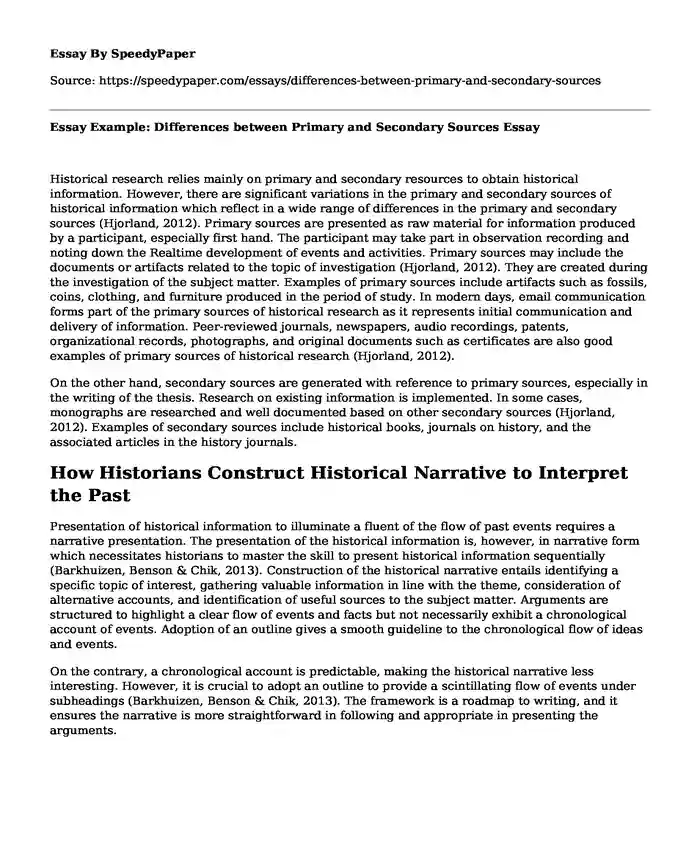
| Type of paper: | Course work |
| Categories: | History Data analysis Literature |
| Pages: | 3 |
| Wordcount: | 590 words |
Historical research relies mainly on primary and secondary resources to obtain historical information. However, there are significant variations in the primary and secondary sources of historical information which reflect in a wide range of differences in the primary and secondary sources (Hjorland, 2012). Primary sources are presented as raw material for information produced by a participant, especially first hand. The participant may take part in observation recording and noting down the Realtime development of events and activities. Primary sources may include the documents or artifacts related to the topic of investigation (Hjorland, 2012). They are created during the investigation of the subject matter. Examples of primary sources include artifacts such as fossils, coins, clothing, and furniture produced in the period of study. In modern days, email communication forms part of the primary sources of historical research as it represents initial communication and delivery of information. Peer-reviewed journals, newspapers, audio recordings, patents, organizational records, photographs, and original documents such as certificates are also good examples of primary sources of historical research (Hjorland, 2012).
On the other hand, secondary sources are generated with reference to primary sources, especially in the writing of the thesis. Research on existing information is implemented. In some cases, monographs are researched and well documented based on other secondary sources (Hjorland, 2012). Examples of secondary sources include historical books, journals on history, and the associated articles in the history journals.
How Historians Construct Historical Narrative to Interpret the Past
Presentation of historical information to illuminate a fluent of the flow of past events requires a narrative presentation. The presentation of the historical information is, however, in narrative form which necessitates historians to master the skill to present historical information sequentially (Barkhuizen, Benson & Chik, 2013). Construction of the historical narrative entails identifying a specific topic of interest, gathering valuable information in line with the theme, consideration of alternative accounts, and identification of useful sources to the subject matter. Arguments are structured to highlight a clear flow of events and facts but not necessarily exhibit a chronological account of events. Adoption of an outline gives a smooth guideline to the chronological flow of ideas and events.
On the contrary, a chronological account is predictable, making the historical narrative less interesting. However, it is crucial to adopt an outline to provide a scintillating flow of events under subheadings (Barkhuizen, Benson & Chik, 2013). The framework is a roadmap to writing, and it ensures the narrative is more straightforward in following and appropriate in presenting the arguments.
Conclusions that can be drawn from Primary and Secondary Sources
Distinguishing between the primary and secondary sources is crucial in drawing of a conclusion from the results of the study. Varied information can be drawn from primary and secondary data. Conclusions in primary sources can be extracted from the data obtained, evidence, and directly from the results of the research. However, conclusions in secondary sources are drawn from the findings of other researchers, interpretations, and conclusions from similar studies. Conclusions from secondary information can also be drawn from primary data interpretation.
Sources Better Used to Write an Essay of Revolutionary War
Secondary sources will be better to deploy in writing an essay on the Revolutionary War. This is because secondary sources provide an account of the war and therefore can as well serve as primary sources in providing information on the progress of the Revolutionary War.
References
Barkhuizen, G., Benson, P., & Chik, A. (2013). Narrative inquiry in language teaching and learning research. Routledge.
Hjorland, B. (2012). Methods for evaluating information sources: An annotated catalogue. Journal of Information Science, 38(3), 258-268. doi.org/10.1177/0165551512439178
Cite this page
Essay Example: Differences between Primary and Secondary Sources. (2023, Feb 07). Retrieved from https://speedypaper.net/essays/differences-between-primary-and-secondary-sources
Request Removal
If you are the original author of this essay and no longer wish to have it published on the SpeedyPaper website, please click below to request its removal:
- Essay Example on Tenure and Promotion Effect on Faculty Work
- Free Essay with Analysis of Yes, The Wealthy Can Be Deserving
- Essay Sample on Workplace Health and Safety Procedures
- Free Essay for Everyone: Capabilities Approach
- Free Essay with a Discussion of Business Entity Structures
- American History Essay Sample: The Hispanization of Mexico
- Essay Sample on Immigration in Texas
Popular categories




